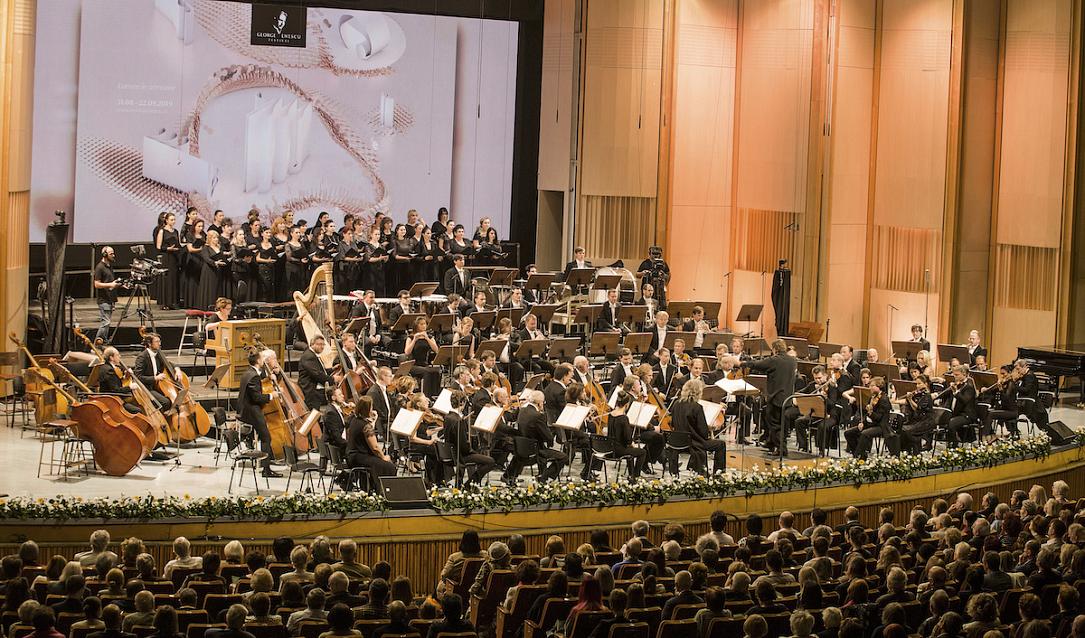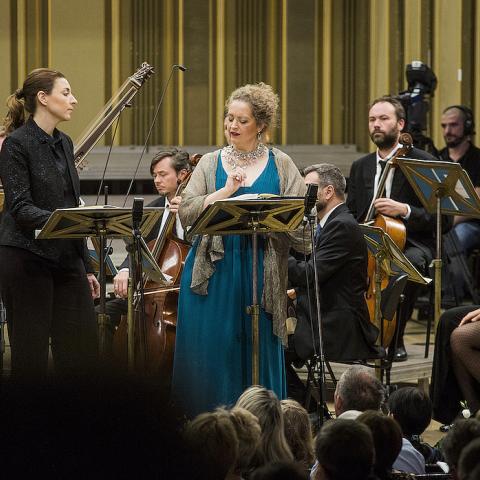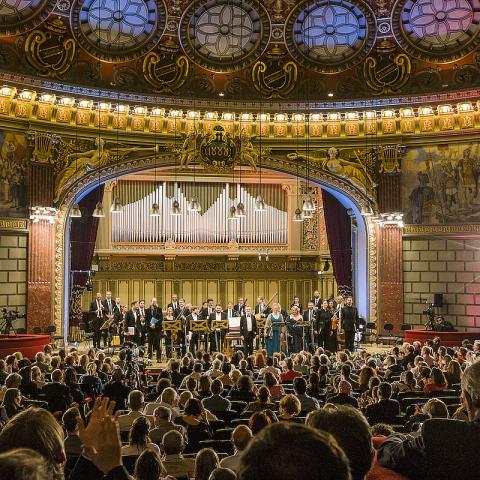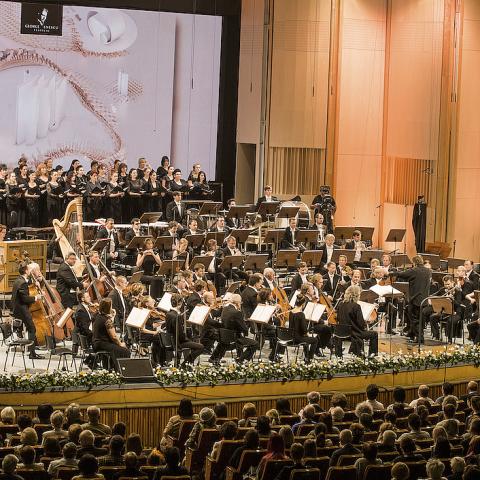“Destination: Bucharest” George Enescu International Festival – the city lives and breathes classical music

Once every two years, when autumn barely makes its presence felt, the George Enescu International Festival returns to the Capital and lends the city part of its special energy. How do you know the classical music festival has started? Often by the groups of passersby, smartly dressed, who stroll every evening on Calea Victoriei, from University Square to Sala Palatului or the Athenaeum, the two main locations where concerts in the festival are held.
At Sala Palatului (the Palace Hall), the parking lot is full, cabs and cars advance slowly past the Crețulescu Church and the sidewalks seem hardly fit to accommodate all those who want to make it to the concert hall.
The hum and buzz on the steps and inside Sala Palatului are linguistically diverse. Conversations in English and French mix with those in Italian or German and not only. Because the public is of different nationalities and ages. Whoever takes a peek inside the concert hall during a festival concert will not share the concerns of those who think classical music does not manage to attract a young audience. From children aged 6 or 7, to high schoolers or students at the Conservatory, carrying their instruments with them, they are all there, alongside experienced concert-goers, corporate types who come straight from work or couples who spend their evening at a concert. High heels and sneakers, elegant dresses and backpacks – the audience of the festival reflects the concept of this year’s edition: “The world in harmony.”
The Enescu Festival manages every time to deliver the joy of memorable performances, of meeting favorite artists or of seeing again friends who are passionate about classical music. During the break, the more audacious members of the audience strike conversations with the musicians who remained on stage to tune their instruments, while others hope to meet their favorites backstage. “I want a photo with Julia Fischer and her autograph,” one student carrying a violin case tells the group of friends with whom she is trying to go backstage. They don’t succeed, unlike an older couple who manages to go behind the scenes at the first concert of the Royal Concertgebouw orchestra. Some artists hold autograph sessions at the end of the concerts, another opportunity to meet them.
If for some admiration translates into a selfie with their favorite musician, for others offering a flower is the perfect way to repay the joy that their performances brought. Many of the musicians who went on stage at the festival, from Patricia Kopatchinskaja to Vadim Repin, received such small tokens of admiration, besides the lengthy applauses of an audience where the stars of the festivals mingled as spectators. Among them, conductor Vladimir Jurovski, the artistic director of the festival, spotted at the concert of the Romanian Youth Orchestra. Applauses are offered enthusiastically, sometimes in between the parts of a symphony, but are promptly hushed over by the connoisseurs, all to the amusement of the orchestra members.
Evaluations are being made,and, as the festival advances, comparisons start. Tchaikovsky’s Fifth Symphony performed by the Berlin Philharmonic or the Oslo Philharmonic? Enescu’s Third Symphony with the Berlin Radio Symphony Orchestra or the Maggio Musicale Fiorentino? Rankings emerge as do verdicts, inevitably subjective ones. One thing is certain: the opportunities to choose were not few.
This year’s edition was the most complex so far, with over 80 concerts in the capital and another 30 concerts in ten cities in the country and six cities in the world (Florence, Berlin, Liège, Toronto, Montreal, Chișinău). As it usually happens, the festival brought to Bucharest some of the best-ranked orchestras of the world.
For the second time at the festival, after the 2015 edition, Berliner Philharmoniker was in Bucharest alongside chief conductor Kirill Petrenko, who recently started his mandate with the orchestra, the only one in the world whose musicians elect their head conductor. Ludwig van Beethoven’s Ninth Symphony was part of the program presented in Bucharest. The orchestra also performed the piece at their inaugural concert with Petrenko and at an open-air concert at the Brandenburg Gate, a week before their Bucharest performance. A special moment, during the Berlin orchestra’s second concert, was the encore offered by violinist Patricia Kopatchinskaja alongside Romanian Laurențiu Dincă, a violinist with the Berlin Philharmonic since 1984, and dedicated to him. The Berlin Philharmonic also announced in a video feature dedicated to the Romanian musician that this was his last tour with the orchestra before retiring.
An enthusiastic welcome awaited also violinist Liviu Prunariu, a concertmaster of the Royal Concertgebouw, the orchestra that traditionally delivers the concerts held at the end of the festival. Rundfunk-Sinfonie Berlin together with Vladimir Jurovski offered a much appreciated performance of George Enescu’s Third Symphony. The St. Petersburg Philharmonic Orchestra received lengthy applauses for their performance of Dmitri Shostakovich’s Violin concerto no. 1, with Vadim Repinas soloist, and of Antonin Dvořák’s New World Symphony, with Christian Badeaconducting. The Orchestra and Choir of the Maggio Musicale Fiorentino, with Fabio Luisi conducting, offered the audience Verdi’s Requiem and an Italian perspective on Enescu’s Third Symphony. At the same time, the public spent memorable evenings alongside London Symphony Orchestra, led by Gianadrea Noseda, Staatskapelle Dresden and pianist Yuja Wang, conductor Vasily Petrenko, who returned to Bucharest alongside the Oslo Philharmonic Orchestra, and the Orchestre National de France, with Emmanuel Krivine conducting and pianist Evgheny Kissin as soloist.
Out of the over 300 works presented at the festival, covering the history of music from the Baroque period to the 21stcentury, 35 works were composed by George Enescu. His Third Symphony, written during the First World War, between 1916 and 1918, was performed twice at this year’s edition of the festival.
A classical music marathon and very many premieres
Just as it happened at its previous edition, the festival continued to promote new music with the Music of the 21stCentury section and the second edition of the International Forum of Composers. The forum brought to Bucharest personalities such as Krysztof Penderecki, known for his Threnody to the Victims of Hiroshima or for the music of films such as The Shining, The Exorcist, Kashrick, The Mask and Shutter Island; Mark-Anthony Turnage, one of the most important contemporary British composers and the author of several operas, including Anna Nicole, which premiered at the Royal Opera House in 2011, or Coraline, based on a work by Neil Gaiman; Unsuk Chin, the author of seven electronic operas; Nicola Piovani, the winner of an Oscar for the soundtrack of Roberto Benigni’s La vita è bella; Philippe Manoury, José María Sánchez-Verdú, Xiaogang Ye, Eric Montalbetti and many others.
An important part of the festival’s program was dedicated to opera, from Baroque masterpieces to 20thcentury works.
Many operas were presented for the first time in Romania at the festival, in concert versions, some accompanied by multimedia projections. Moreover, the public could listen for the first time Arthur Honegger’s dramatic oratorio Jeanne D’Arc au bûcher, with actress Marion Cotillard as Jeanne d’Arc, and Bluebeard's Castle, the only opera composed by Bela Bartók.
For several editions now, the festival showcases Baroque music in the By Midnight Concerts section, bringing to Bucharest ensembles dedicated to performing this kind of music. Among them, Les Talens Lyriques,established by conductor Christophe Rousset, who presented George Frideric Handel’s Agrippina.
Elsewhere, many star soloists went on stage at the festival, among them Diana Damrau, Joyce DiDonato, Rolando Villazon or Sir Bryn Terfel.
Another premiere of this year’s edition of the festival was the Mozart Week in Residence program, brought to Bucharest and curated by tenor Rolando Villazon, the artistic director of Salzburg’s Mozartwoche, the famed festival dedicated to the composer born in the Austrian city. The program covered operas in concert,but also an exhibition on Mozart’s life, in an attempt to bring a fresh light to the composer’s music and personality. The Mexican tenor, often compared at the beginning of his career to Placido Domingo and labeled by critics his successor, performed three times at the festival in Bucharest.
Where was sound of the Enescu Festival heard?
Not only in concert halls. The George Enescu Square in Bucharest hosted several events for a wide audience, besides broadcasts of several concerts in the festival, concerts of young musicians, dance sessions and musical quizzes, and projects for children. The little ones could enjoy the Children’s Enescu Festival, at the Comic Opera for Children, in a program that included festival concerts adapted for the young classical music fans.
For three weeks, the music of the festival could be heard all over the city. Through the Cantus Mundi program, concerts and recitals were presented in office buildings, commercial centers, parks and museums in the capital. Museicorum2019, a generous program of concerts, took place at the Bucharest City Museum, while the Silent Simphonia project brought the sound of works presented at the 2017 edition of the festival to bookstores, offices and other public venues.
Besides concerts, the public could enjoy guided tours through the city in the footsteps of Enescu, as well as various exhibitions, one of them the result of a national art competition inspired by the works of Enescu.
How to prepare for the next edition of the festival
The organizers of the event usually announce the first details on the next edition of the festival towards the end of the year when the festival took place. Check the festivalenescu.ro website for news about the program and tickets. At this year’s edition, the organizers introduced a pass lottery, meant to increase the chances of purchasing festival passes, such chances being equal for everyone interested. Passes go on sale before the tickets and sell very fast, being often purchased by the festival’s most committed public. Tickets go on sale several months before the event starts. Watch out for the tickets in the Recitals and Chamber Music and By Midnight Concerts sections – these are held at the Athenaeum, where the main hall has some 790 seats and the available tickets are fewer compared to those available in the Great Orchestras of the World section, held at Sala Palatului, which can seat some 4,000 people. When purchasing online, it is advisable to choose the automatic selection of the seats option so as to speed up the buying process.
This text is part of a project under the program of promoting the touristic heritage "Destination: Bucharest", carried out by the Bucharest City Hall through the Public Monuments and Touristic Heritage Administration (AMPT).
(photos by Kathrin Weident/Romania-Insider.com for AMPT)



















